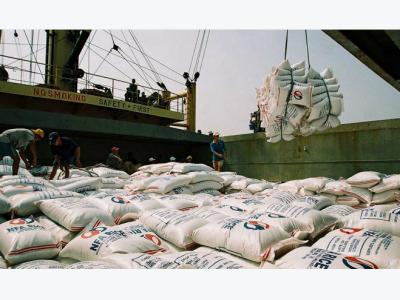Vietnams Q1 rice exports down but Chinese appetite set to grow

Vietnam's first-quater rice exports have fallen to a two-year low, but the outlook remains positive as China, its biggest buyer, is forecast to import more this year. Photo by Reuters/File Photo
'China has a major impact on Vietnam's rice exports because when China starts making inquiries, prices rise and other buyers turn away from Vietnam.'
Vietnam's first-quarter rice exports have fallen to a two-year low, but the outlook remains positive as shipments to China, its biggest buyer, are forecast to grow this year, traders and industry reports said.
"The land border gates are now officially closed to Vietnamese rice, so export prices have dropped," a trader at a foreign company in Ho Chi Minh City said, explaining that more fresh winter-spring grain arriving from the Mekong Delta has contributed to the lower prices.
China has been the biggest consumer of Vietnamese rice since 2012, when it overtook Indonesia. Last year, Beijing and Hanoi signed an agreement to boost the rice trade via official channels. China has named 22 Vietnamese export firms that it deems qualified to deal with.
He said the Chinese government prefers official trade as it cannot tax rice imported via land. China officially imports around 2 million tons of Vietnamese rice a year, while another 1-1.5 million tons enters China via land, and that volume is not included in Vietnam's official statistics.
This week, Vietnam's 5-percent broken rice prices fell to $347-$350 a ton, free-on-board Saigon Port, from around $360 a ton in late February. At $347, the price is the lowest since February 16.
Vietnamese rice is now cheaper than Thai rice of a similar grade, which stood this week at $374 a ton, according to the Thai Rice Exporters Association.
Exports fall
Shipments from Vietnam, the world's third-biggest rice exporter after India and Thailand, in the January-March period dropped 24 percent from a year ago to an estimated 1.2 million tons, a two-year low, the government said on Wednesday.
The estimate is the lowest since the first quarter of 2015, when Vietnam shipped 1.13 million tons.
Overall weak demand is the reason for the drop, with potential buyers, including the Philippines and Mexico, still absent, traders said.
Earlier this month, Mexico approved for 150,000 tons of rice to be imported at a zero percent tariff to meet domestic demand and diversify its supply sources. Traders said the demand would cut the market share currently held by the United States and open the door to Vietnamese rice. However, Mexico has yet to act on the decision.
China imported 331,300 tons of Vietnamese rice from January-February, up 41 percent from a year ago, based on data from Vietnam's agriculture ministry. In February alone, it bought 36 percent of Vietnam's total rice exports, more than doubling the market share it held a year ago.
China's imports
China's rice imports in the 2016/2017 market year ending this June are forecast to rise 4 percent to 5 million tons, with Vietnam and Thailand remaining its key suppliers, the U.S. Department of Agriculture said in a report released on March 21.
It said China's rice imports would continue to be profitable if import prices stay below China’s floor price of $389 a ton, while the average CIF (cost-insurance-freight) rice price from Southeast Asia to China is $350/ton.
"China has a major impact on Vietnam's rice exports because when China starts making inquiries, prices rise and other buyers turn away from Vietnam, so overall the volume does not rise significantly," a second trader said.
He noted that more paddy is coming from the Mekong Delta, which supplies 90 percent of Vietnam's rice exports.
Mekong Delta farmers have finished harvesting around half of the 1.53 million hectares (3.78 million acres) planted for the crop, the Vietnam Food Association said.
Output down
Harvesting of the crop, the biggest among the delta's three crops a year, ends in April. Paddy output is forecast to ease to 10 million tons, down 1.3 percent from last year, which is the third drop in a row, the agriculture ministry said, blaming unseasonal rain during the heading stage in November-December 2016.
In the long term, Vietnam's rice acreage and output will further fall as the country seeks to restructure its cash crops, officials said.
On Wednesday, Prime Minister Nguyen Xuan Phuc suggested related agencies to switch from low-yield rice to medicinal plants if the latter has higher benefits, a government statement said, as part of efforts to boost Vietnam's pharmaceutical sector.
But the government also regards rice as essential to national food security, a status that gives rice businesses access to credit and adequate support.
Phuc told a conference on March 15 to look for solutions for sustainable production in the Mekong Delta.
The premier has urged the trade ministry to strip the food association's right to set floor prices and to allocate shipments to key markets, factors that exporters said have been hindering overseas sales.
The association has projected Vietnam's rice exports this year will reach around 5 million tons.
Shipments fell to 4.8 million tons in 2016, the lowest since 2008, due in part to thinner demand and growing regional competition.
Có thể bạn quan tâm
 Vietnam’s dragon fruit: Open door to Myanmar
Vietnam’s dragon fruit: Open door to Myanmar Myanmar has offered license-free imports of Vietnamese dragon fruit. This is an important agreement reached at the ninth session of the Viet Nam
 Concerns emerge over farmland limit rise
Concerns emerge over farmland limit rise Many agricultural experts believe an increase in the farmland limit and land accumulation should be done in a careful manner, or else farmers would become
 Thanh Hoa develops animal husbandry
Thanh Hoa develops animal husbandry The central province of Thanh Hoa is taking a number of measures to develop animal husbandry for the creation of high-quality livestock products.